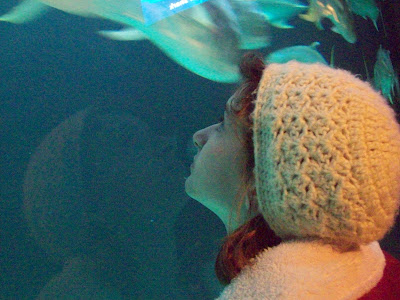 |
| Fisher as a young woman |
"...We came in to find Mother's door open and her in her Chinese robe in the Irish chair. She looked very pretty -- her skin was younger and fresher than it had been for years, and I felt that she smelled better, probably, in her intimate cracks -- and she was playing 'The Pretty Tyrant' as she had not played it since she was a bride, I wager. It has its boring side ... mainly because her twenty-five-year habit of talking anywhere in the house and expecting everyone anyplace else in the house to listen has become exaggerated by her power, as an invalid, so that she talks in her rather weak voice almost constantly and expects us to listen no matter where we are. That may be one reason why Rex is such an accomplished deaf person. Anyway, we are so relieved to have Mother still alive that we submit with fatuous and unbreathed gladness to her coquetry, and only occasionally do we admit to boredom." (477)
I read that, and whispered, Yes to myself. Such a familiar family experience. Such accurate description of both person and feeling. A sad admission that we know people like this, and a fearful worry that we are a bit like this ourselves.
Fisher is more careful and literary in her writings intended for publication. This is an everyday journal intended for the fire, eventually. At 32, she's already published her first successful book, Serve It Forth, but has not repeated that success. Instead she is struggling through the illness that will take her husband's life a few months from this time. Her prose is entering maturity. In a later entry she writes:
"Just now T. and I went out from the warm lighted study and the whuddering firelight of the living room to the porch and watched a half rainbow grow and die against the hills. Sunlight, long and yellow, flung itself against the middle distance of San Jacinto in an intense blot -- San Jacinto hills, not the mountain, which was blue and far from us. The hills showed their folds and meadows like old elephant hide, and in front of them the valley and the little lizard of land blazed with arsenic, Paris gray, as violent as dying California leaves can be, yellow and hideously beautiful. The rainbow curved up, more and more intensely, never higher than the quarter-arm but plainly from Soboba, and then it faded. We felt cold and came into the reassurance of the house. The harsh yet measured beauty of the scene before us was disturbing." (T. is her husband.) (478)
When she wants to turn descriptive, lovely and literary, she can in a moment. A few sentences later she notes, "I am verbose but uninspired" today. "My mind is full of my own despair, muted fortunately. It is best to write of things like weather and furniture." Beautiful passages like the one above are a second choice to the things that truly fill her mind. She says in the next entry, "My heart is heavy, thinking of my friends in France and of England so hard pressed. I can hardly bear to think of anything at all these days, and dwell resolutely on the growth of a kitten or an acacia tree and the progression of clouds in a winter sky." It is late 1940.
I have loved M.F.K. Fisher for a many years. It is her voice that I love, so clearly and carefully revealing the inner woman, I thought, although her family and friends seem to indicate she kept herself well-concealed. She was prolific, and one could read her books alone for years, over and over. I'm on page 477 of her compiled journals. I have about ten other of her books.
The passage about her mother is wonderful in its honest accuracy, and her crafted, complex sentence structure. The passage about the hills is lovely in description. Some phrases are perfect, like "The hills showed their folds and meadows like old elephant hide" and "the little lizard of land" and "the reassurance of the house." All these are fresh, new, appealing. But "yellow and hideously beautiful" is over-done." I love the word "whuddering," which she seems to have invented, a very useful word for various sounds, like a fan in a dark, warm room, or one's heart swooshing blood around in the silence.
M.F.K. Fisher is an honest writer. I never feel that she's trying to impress me or overwhelm me with her verbiage. She writes what her inner voice has been rattling on about, all her life. Her pen is only the secretary. I may be diving into her books again, and if I do, you can expect more posts about her style. Most people write about her personal life, which was sometimes tabloidal, or her fame as a gastronome. But I prefer the woman as I found her -- stark, beautiful, self-aware and -assured, and sad.






















































